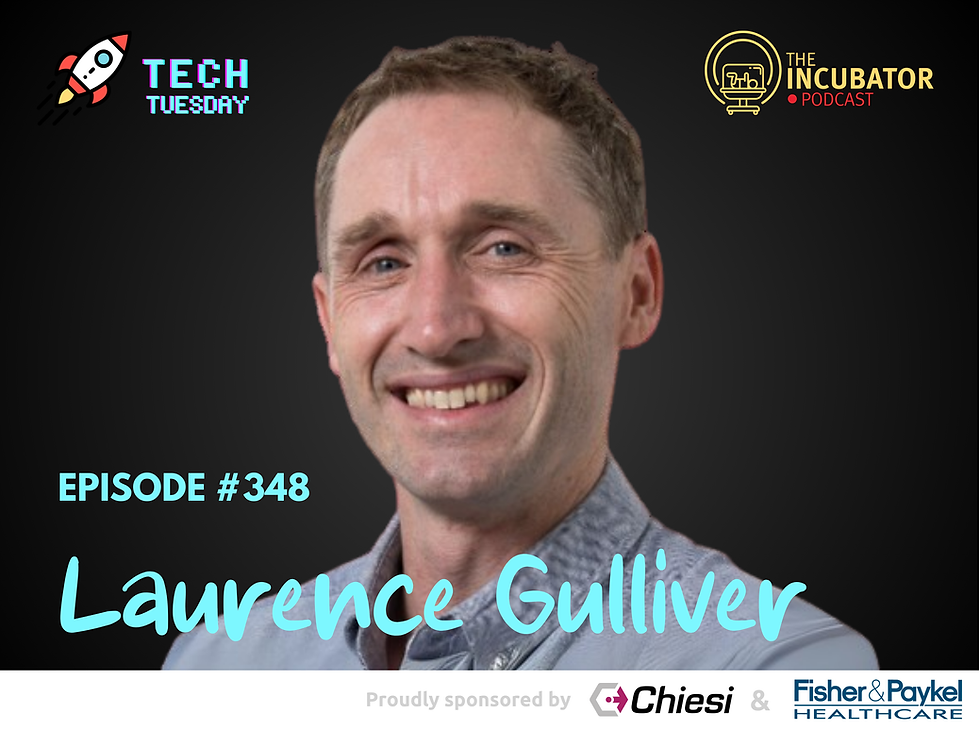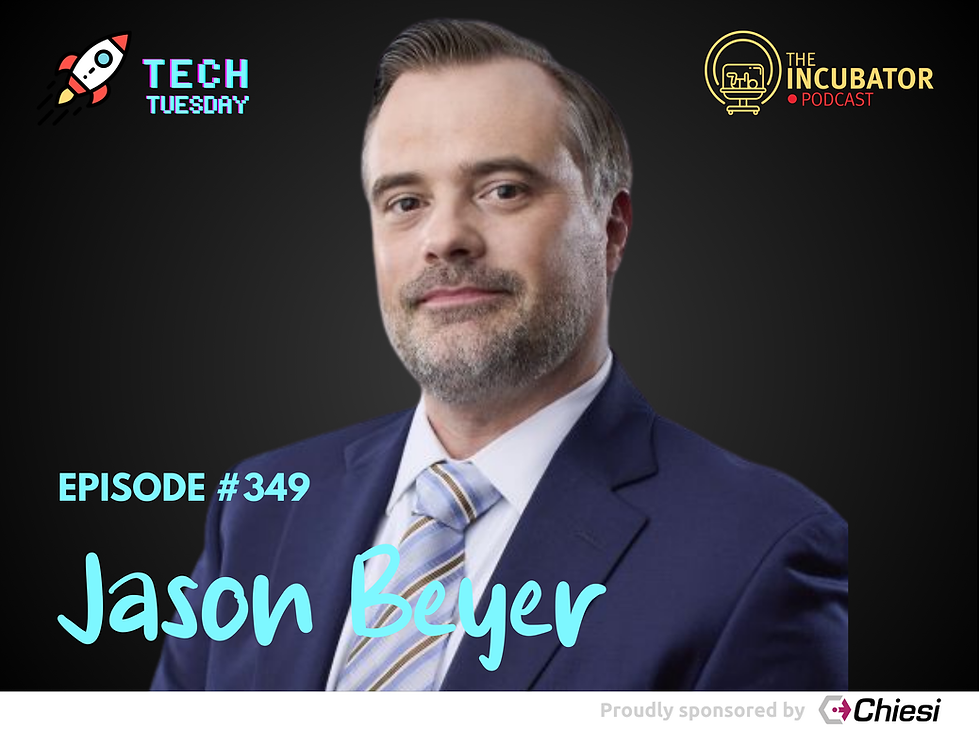#348 - 🚀 CPAP with Purpose: Supporting Babies in the Delivery Room and the NICU (Part 3)
- Mickael Guigui
- Sep 2
- 7 min read
Updated: Sep 14

Hello Friends 👋
In this Tech Tuesday episode, Ben speaks with Laurence Gulliver, General Manager for Humidification at Fisher & Paykel Healthcare. With nearly two decades at the company and a background in mechanical engineering and product development, Laurence has helped guide innovations that have shaped respiratory support for neonatal, pediatric, and adult patients worldwide.
The conversation explores the role of humidification in neonatal respiratory care and why it is often overlooked despite its impact on mucociliary function, secretion management, bronchoconstriction, and thermoregulation. Laurence explains the engineering challenges of delivering consistent humidity through ventilator circuits, the burden of condensation management, and how newer platforms like the F&P 950 are designed to improve performance and usability.
They also discuss Fisher & Paykel’s approach to product development, which relies heavily on feedback from caregivers to ensure technology addresses real-world challenges. The episode closes with a broader look at CPAP therapy, opportunities for further innovation in a seemingly simple modality, and the global vision that drives Fisher & Paykel to design solutions adaptable to diverse healthcare settings.
This conversation highlights how thoughtful engineering and collaboration with caregivers translate into meaningful improvements in neonatal outcomes.
----
This episode is part of a special three-part series on the use of CPAP, supported by Fisher & Paykel Healthcare. Their sponsorship makes possible the logistical production of this podcast series but does not involve curation, moderation, or influence over the content of the discussions.

Fisher & Paykel Healthcare offer a full neonatal care continuum which helps provide the best start possible to our precious babies worldwide.
Watch the design matters video series and discover what drives the innovation behind their neonatal interfaces https://www.fphcare.com/hospital/infant-respiratory/support/design-matters/
----
Short Bio: Laurence Gulliver is the General Manager overseeing the humidification portfolio at Fisher & Paykel Healthcare. With nearly 20 years at F&P, he brings a blend of technical expertise and strategic leadership to products serving adult, pediatric, and neonatal patients. Holding a Mechanical Engineering degree and an MBA, Laurence began in product development and gained international experience in the UK before returning to lead key engineering and management roles. He has played a pivotal role in the development of products like Optiflow Junior and the F&P humidifier platforms, driving global clinical impact.
----
The transcript of today's episode can be found below 👇
Ben Courchia: Hello, everybody. Welcome back to the Incubator podcast. We are back today for an episode of Tech Tuesday, and I am joined in the studio today by Laurence Gulliver. Lawrence, welcome to the podcast.
Laurence Gulliver: Thanks very much for having me.
Ben Courchia: For the people who are not familiar with your work, you're the general manager overseeing the humidification portfolio at Fisher and Paykel Healthcare. With nearly 20 years at Fisher and Paykel, you bring a blend of technical expertise and strategic leadership to products serving adults, pediatric, and neonatal patients.
You have a degree in mechanical engineering and an MBA. You began in product development, gained international experience both in the UK before returning to Fisher and Paykel, and have played a pivotal role in the development of products we use in the NICU, such as the OptiFlow Jr. and the Fisher and Paykel humidifier platforms, which have had a global clinical impact. Laurence, it's a pleasure to have you on the podcast today.
Laurence Gulliver: Thanks very much, Ben, and thanks for the kind intro. Of course, I hasten to add that my role is only a very small part of everything we create as part of a team here.
Ben CourchiaI: In the bio, we blow that up tremendously. If it was on our bios alone, we’d be the single agents of revolutions around the world. I think in your background, though, there's a piece that's quite interesting – your focus on the development of humidifier platforms. For many of us, especially those with an interest in respiratory disease, this is a critical aspect of respiratory support that can sometimes be overlooked. I often see younger colleagues rush to a vent or a non-invasive interface to troubleshoot, while the humidifier is checked last, even though it’s such a critical piece, especially in babies with tracheostomies. From a mechanical engineering standpoint, can you tell us about the importance of delivering appropriately humidified air, and the challenge of doing so for babies connected through tubing to respiratory support?
Laurence Gulliver: Sure, I’ll try and break that down into importance and challenges. Fisher & Paykel Healthcare has been delivering humidity for 55 years. It’s where we started, and we want to remain market leaders.
From an engineering lens, the benefits are several. Listeners will know about mucociliary transport and how it’s impacted by humidity. With inadequate humidity, mucus thickens, secretions build up, and outcomes worsen. There’s also bronchoconstriction to consider. Humidity helps prevent that.
But the one I find most interesting for neonates is thermoregulation. When humidity is inadequate, the energy needed to evaporate water into vapor often comes from the patient. For neonates, already vulnerable to heat loss, that’s critical. We put them in incubators and do everything possible to keep them warm. Humidity plays a role in preventing evaporative heat loss.
Ben Courchia: Yeah, and I think that's such a critical aspect of care. We want to deliver warm air, yet the tubing transmits this warm air and condensation builds. Then we’re battling droplets that accumulate. And in my experience, NICU temperatures vary even between areas of the same unit. How do you navigate that?
Laurence Gulliver: That’s one of the challenges. Condensate is interesting and often misunderstood. Caregivers know it as a nuisance, a burden. Over the years, we’ve improved systems with heater wires, insulation, and tools like the VAC to remove liquid water. But condensate isn’t “extra” humidity; it’s lost humidity. If condensate occurs, that’s humidity not reaching the patient. So not only is it a burden, but it’s also suboptimal care.
We’re improving, though. For example, a NICU nurse recently told me their new Fisher & Paykel 950 humidification system works so well that nurses no longer even know the term “rainout.” It’s no longer part of daily practice. That’s a generational shift, and positive progress.
Ben Courchia: That’s fascinating. You mentioned the new F&P 950 system. I haven’t used it yet, but from what I’ve seen, it almost looks like the traditional humidifier has been split in half – the top remains, the bottom is gone. What’s the innovation behind this new circuit, and how does it differ from prior ones?
Laurence Gulliver: The 950 has been available in global markets for a while and in the U.S. for over a year. It’s essentially a computer at the bedside, it’s very different from previous generations. It uses inputs, algorithms, and adaptation to deliver high humidity with low condensate and minimal caregiver intervention. Usability is also key. For example, it has fewer alarms, and when alarms occur, they’re informative. That might seem trivial, but if caregivers don’t have to worry about the humidifier, that’s a win. If it does what it’s supposed to do and fades into the background, that’s perfect
It’s not technology for technology’s sake, but for usability and outcomes. It measures the environment with integrated probes and has a large screen. The point is: it’s anchored in caregiver feedback and patient needs.
Ben Courchia: That makes sense. And I love that you emphasized technology not for technology’s sake, but to address caregiver needs. How do you go about understanding those needs of the NICU nurses, physicians, or respiratory therapists, and then tailoring your objectives accordingly?
Laurence Gulliver: That’s a great question. For neonates especially, our channel has to be through caregivers. We rely on their insights. I don’t like the idea of an engineer designing something in an air-conditioned office in Auckland that’s shipped to NICUs worldwide. Engineers need to be informed by what’s happening globally.
Premature babies only exist in NICUs, so we need access to caregivers and parents to understand what works and what doesn’t. Since babies can’t speak for themselves, we infer from caregiver input. At the end of the day, our role is to provide the best possible tools for caregivers to do their jobs. Usability, outcomes, and ease of care drive everything.
Ben Courchia: That’s great to hear. My next question is about innovation. We’ve been talking about CPAP in several recent episodes. One of CPAP’s big advantages is its simplicity. From an engineering standpoint, do you still see room for innovation in CPAP, or have we already reached its optimal form?
Laurence Gulliver: Absolutely there’s room for innovation. Our teams are structured to deeply understand clinicians’ needs and improve therapies. We’ve been doing humidification for 55 years and still see opportunities to improve. The F&P 950 has made some improvements, but we believe we can still do more. The same is true for CPAP. Yes, it’s simple and effective, but usability, performance, and clinical outcomes can always improve. We’re not complacent; it’s a “we’re not done” mindset.
And when it comes to neonates, it’s easy to stay motivated. Helping to save babies is a powerful driver for continued innovation.
Ben Courchia: That’s so cool, that despite being on opposite sides of the globe, our motivations are identical. Another question: Fisher & Paykel has a global vision. Why is it so important to think globally rather than just locally?
Laurence Gulliver: We’re based in New Zealand, but we’re a global company with sales in over 130 countries. Markets vary greatly when considering nursing ratios, hospital resources, and priorities differ. So, we provide different solutions. The F&P 950 is one, but we also offer other systems with different features. Some prioritize usability over performance, depending on the needs of the setting. Being global means designing for a wide range of caregivers and environments.
Ben Courchia: Thank you for that. Before we wrap up, a personal question: with your engineering background, why did you choose to join Fisher & Paykel and work in healthcare, specifically with pediatric and neonatal patients?
Laurence Gulliver: Honestly, when I was at university, Fisher & Paykel Healthcare was well-known. I thought it was the obvious company to work for, but I wanted to explore other opportunities first. I applied for an internship here, gave it a try, and the rest is history. The culture of everyone pulling in the same direction to do something meaningful and positive really changed my perspective. As an engineer, you can work in many industries and create cool things. But here, we also have a positive impact on patients and families. That’s the hook. I left for a few years to work overseas in medical devices but came back for that same motivation. And, of course, engineers love technology and creating. At Fisher & Paykel, we get to do that and have impact.
Ben Courchia: That’s awesome. Engineering with purpose is like a cheat code.
Laurence Gulliver: Exactly. We even have an ethos called “care by design,” which speaks to our motivation. Design is important but so is channeling it toward improving care.
Ben Courchia: Well, thank you for sharing that personal note, Lawrence. It was a pleasure to chat with you today. Thank you for all the work you’re doing. We’ll link to the Fisher & Paykel website in the show notes for listeners who want to learn more about your latest innovations. Have a great rest of your day.
Laurence Gulliver: Thank you so much, Ben. I really appreciate it and enjoyed talking with you.




Comments